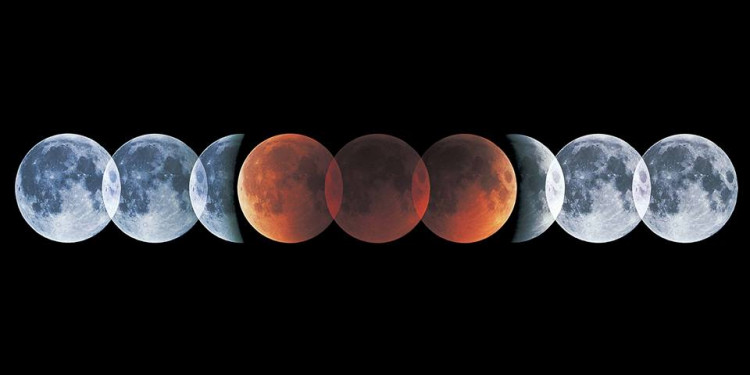
Blue Moon:
When two full moons happen in the same calendar month (January 2, 2018 and January 31, 2018), the second full moon is called blue moon.
Super Moon:
Super Moon happens when the moon’s closest approach to Earth (perigee) in a single orbit coincides with a full moon. A super moon is up to 14% bigger and 30% brighter.
Blue Moon /Copper-Red Moon:
This time, the super moon happens to be on the same day as the lunar eclipse. When a total lunar eclipse occurs, the moon looks orangish, copper coloured or reddish because of the scattering of sunlight in the earth’s atmosphere. Therefore, the moon is called Blood Moon or Copper Moon.
Lunar eclipse
A lunar eclipse is a spectacular celestial show, during which the bright, pearly-white disc of the full Moon turns dark, and sometimes takes on the colour of dark copper, or even dried blood. A lunar eclipse occurs when the Sun, the Earth and the Moon are so aligned that for a period of time, the full Moon passes through the shadow of Earth in space (called Earth’s Umbra).
Why is it special?
1.The January 31 full moon is also the third in a series of three straight full moon super moons – that is, super-close full moons. It’s the first of two Blue Moons in 2018. So it’s not just a total lunar eclipse, or a Blue Moon, or a super moon. It’s all three … a super Blue Moon total eclipse!
2.The moon will be closest to Earth on Tuesday, just over 223,000 miles (359,000 kilometers).
3..There may be slightly higher tides in rivers and seas due to super moon but nothing very alarming about it.
4.For the Americas it is happening after 152 years and the last time it happened was in 1866.
5.In Asia, the last Blue Moon and total lunar eclipse happened on December 30, 1982. So, it is happening after 35 years for sky enthusiasts in India.
How can one watch the lunar eclipse?
1.Locate a high-rise building or any open space from where moon rise will be clearly visible.
2.We do not need any special binoculars or a telescope to see this phenomenon.
3. It can be seen through the naked eye.
4. If binoculars and simple telescopes are available, the moon will look a little more attractive. The company of friends and family could further enhance the experience.
Can anybody watch the phenomenon?
Yes! There is no scientific evidence of any harmful rays or increase in microbial activity during eclipses. It is absolutely safe to eat, drink water and continue doing our normal activities during eclipses.
At what time can we see the eclipse?
If you live in North America or the Hawaiian Islands, this lunar eclipse will be visible in your sky before sunrise on January 31.
On the other hand, if you live in the Middle East, Asia, Indonesia, Australia or New Zealand, this lunar eclipse will happen in the evening hours after sunset on January 31.
In India, the eclipse will start around 17:18 IST. It will be total at 18:21 hours and remain totally eclipsed till 19:37.
Then after, the total eclipse will end and the Moon will slowly come out of the shadow of the Earth, the partial eclipse ending around 20:41 hrs. The totality of the eclipse will last for about 1 hour and 16 minutes.
Eclipse times in Universal Time
Partial umbral eclipse begins: 11:48 Universal Time (UT)
Total eclipse begins: 12:52 UT
Greatest eclipse: 13:30 UT
Total eclipse ends: 14:08 UT
Partial umbral eclipse ends: 15:11 UT
